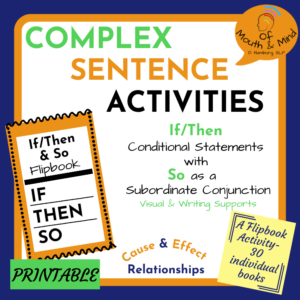Do you dread teaching complex sentence exercises to your students with language disorder? Think about it…..correlative conjunctions, subordinate conjunctions, or even teaching problem-solving and solution text structure. Most of the work for these types of lessons always revolves around “dressing up” the objectives and activities to entice students. Then, keeping the students engaged feels like a feat of pure luck or genius. At least that’s how I usually feel. But, I remind myself how critical learning complex language structures is for my language-disordered students.
The Role of Complex Sentence Exercises
Comprehension as well as written and verbal use of complex sentences is required for competence from upper elementary through high school and beyond. This is especially true for specific content areas such as science, history, social studies, as well as specific technical areas. Scott & Balthazar state, “Learning within a discipline requires an understanding of the way that discipline uses language to encode its unique nature and purposes.” Content learning requires the use of content-specific vocabulary, relationships, and language structure (syntax).
“From the mid-elementary through the secondary school years, the main job of a student is to learn, and this takes place increasingly in the context of language that is written (not spoken), is expository/informational (not narrative), and is discipline-specific” (Scott & Balthazar). This type of structure is also presented orally within lectures and other presentation formats. This demands a higher level of language processing, reading, and writing abilities when compared to basic narrative-style learning input for younger children. Of course, it is often our students who have a language disorder that are impacted by such factors. Additionally, these students are more likely to present with reading and writing deficits that further necessitate addressing complex sentence exercises. Scott & Balthazar include information on sentence complexity, assessment of language structure, and instruction of complex sentence structures.
One of the most challenging complex sentence structures is conditional statements, particularly If/Then statements. “These useful but tricky structures rely on the use of ‘if’ and specific clauses to communicate the reason-result relationship between two ideas” (Garside). The difficulty that these types of sentences present, is that their verb form indicates a specific meaning and function. The verb tenses “communicate distance from reality” (Garside). These meanings can be one of the following: facts/scientific truths, predictions/warnings, dreams/wishes/speculation, and regrets/imagined pasts (Garside).
Engaging Students in Conditional Sentence Exercises
So, how do we engage students in learning complex sentence structures? Simply, have fun using imagination! Conditional statements allow for our imaginations to run wild. Not only can we relay truths, but we can create fun and fantastical ideas using if/then statements. If I were an astronaut, then…… just think of the possibilities in language generation! In Tom Garside’s blog, “If I Could Be Anywhere….How to Teach Conditional Sentences”, he provides some teaching ideas that are innovative and exciting. He discusses the use of not only cause/effect picture scenes but also real-life timelines and imagined lifeline events for activities.
For another fun idea, I have created If/Then flipbooks for supporting understanding and formulating (oral & written) conditional sentences. There are Level 1 and Level 2 instructions. Level 1 is for If/Then exercises. Level 2 allows for further complexity by using “so” as a subordinating conjunction in providing extended thinking regarding purpose or reasoning. I have included directions, student instructional tools (visual supports), writing worksheets with punctuation explained, blank If/Then flipbook pages, and 30 flipbooks under the categories of School, Home, and Health/Safety. My Resources page will provide you with many resources for teaching the structure of language. Click on the image below to review this specific resource in my TpT store.
You may also want to take a look at my blog “Why Teach Complex Sentence Structure?” for information on subordinating conjunctions.
Join my community and receive a complimentary 26-page pdf
Stuttering Therapy Activities Resource!
Feel confident that the therapy you provide is effective, evidence-based,
and engaging!
Resources:
Garside, Tom. “If I could be anywhere…how to teach conditional sentences” Web blog post. Language Point Teacher Education LTD (Sep 24, 2021) https://www.languagepointtraining.com/post/if-i-could-be-anywhere-how-to-teach-conditional-sentences
Scott, Cheryl M. PhD, CCC-SLP & Balthazar, Catherine PhD, CCC-SLP. “The Role of Complex Sentence Knowledge in Children with Reading and Writing Difficulties.” Perspect Lang Lit. 2013 Summer; 39(3): 18-30. https://www.ncbi.nlm.nih.gov/pmc/articles/PMC4373700

